XYZ Company Marketing: Virtual Teams vs Decentralized Strategies
VerifiedAdded on 2023/05/30
|5
|1243
|70
Report
AI Summary
This report explores the viability of using virtual teams as a marketing strategy for XYZ Company, comparing it against decentralized marketing teams. It defines virtual teams, highlights their effectiveness in cost-saving, talent acquisition, and productivity, and discusses the challenges like lack of cohesiveness and potential client skepticism. The report contrasts virtual teams with decentralized marketing teams, weighing the advantages and disadvantages of both approaches. Ultimately, the report recommends implementing a virtual team strategy for XYZ Company, citing its overall advantages, while also acknowledging the importance of addressing its limitations to ensure successful marketing operations. Desklib provides students with similar solved assignments.
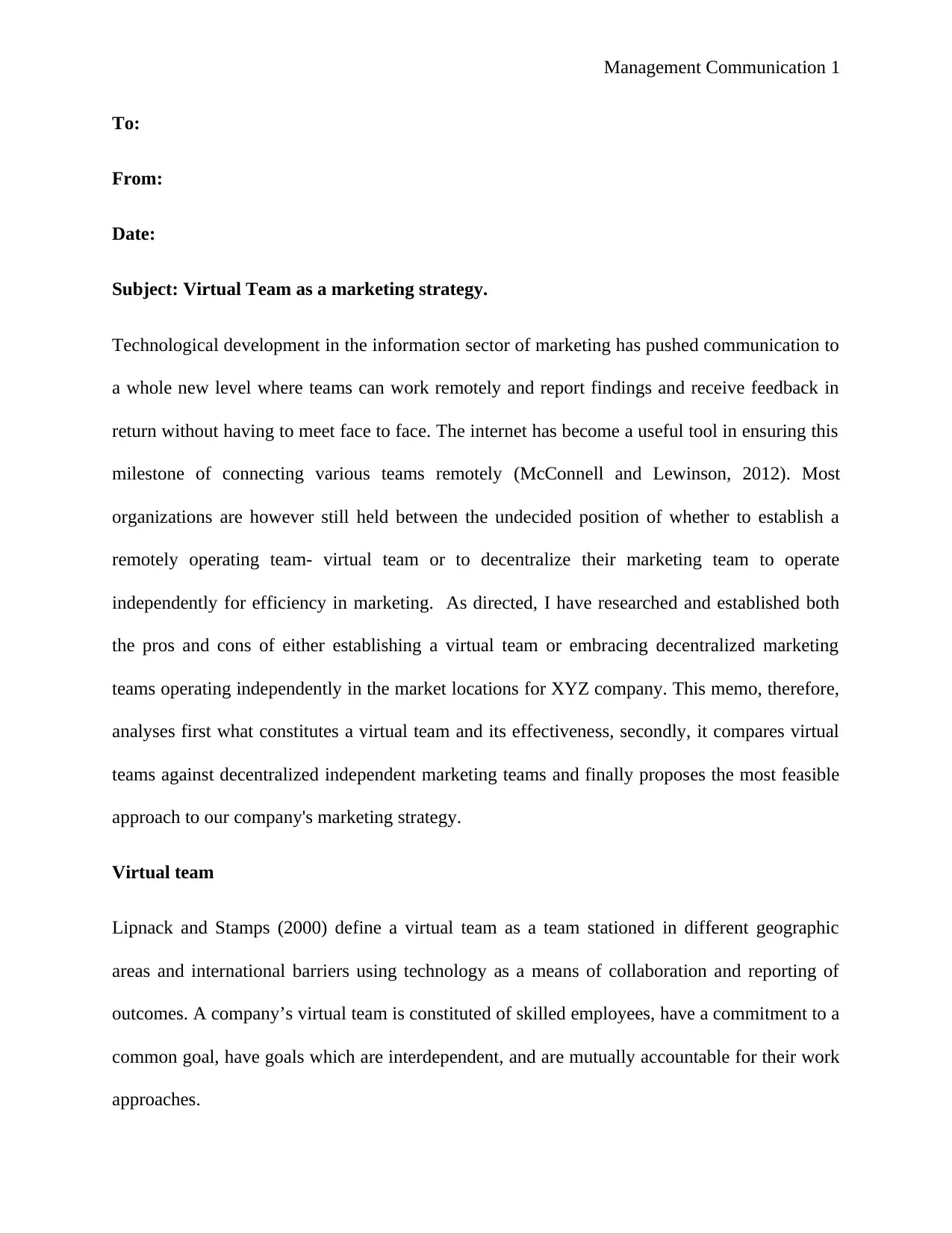
Management Communication 1
To:
From:
Date:
Subject: Virtual Team as a marketing strategy.
Technological development in the information sector of marketing has pushed communication to
a whole new level where teams can work remotely and report findings and receive feedback in
return without having to meet face to face. The internet has become a useful tool in ensuring this
milestone of connecting various teams remotely (McConnell and Lewinson, 2012). Most
organizations are however still held between the undecided position of whether to establish a
remotely operating team- virtual team or to decentralize their marketing team to operate
independently for efficiency in marketing. As directed, I have researched and established both
the pros and cons of either establishing a virtual team or embracing decentralized marketing
teams operating independently in the market locations for XYZ company. This memo, therefore,
analyses first what constitutes a virtual team and its effectiveness, secondly, it compares virtual
teams against decentralized independent marketing teams and finally proposes the most feasible
approach to our company's marketing strategy.
Virtual team
Lipnack and Stamps (2000) define a virtual team as a team stationed in different geographic
areas and international barriers using technology as a means of collaboration and reporting of
outcomes. A company’s virtual team is constituted of skilled employees, have a commitment to a
common goal, have goals which are interdependent, and are mutually accountable for their work
approaches.
To:
From:
Date:
Subject: Virtual Team as a marketing strategy.
Technological development in the information sector of marketing has pushed communication to
a whole new level where teams can work remotely and report findings and receive feedback in
return without having to meet face to face. The internet has become a useful tool in ensuring this
milestone of connecting various teams remotely (McConnell and Lewinson, 2012). Most
organizations are however still held between the undecided position of whether to establish a
remotely operating team- virtual team or to decentralize their marketing team to operate
independently for efficiency in marketing. As directed, I have researched and established both
the pros and cons of either establishing a virtual team or embracing decentralized marketing
teams operating independently in the market locations for XYZ company. This memo, therefore,
analyses first what constitutes a virtual team and its effectiveness, secondly, it compares virtual
teams against decentralized independent marketing teams and finally proposes the most feasible
approach to our company's marketing strategy.
Virtual team
Lipnack and Stamps (2000) define a virtual team as a team stationed in different geographic
areas and international barriers using technology as a means of collaboration and reporting of
outcomes. A company’s virtual team is constituted of skilled employees, have a commitment to a
common goal, have goals which are interdependent, and are mutually accountable for their work
approaches.
Paraphrase This Document
Need a fresh take? Get an instant paraphrase of this document with our AI Paraphraser
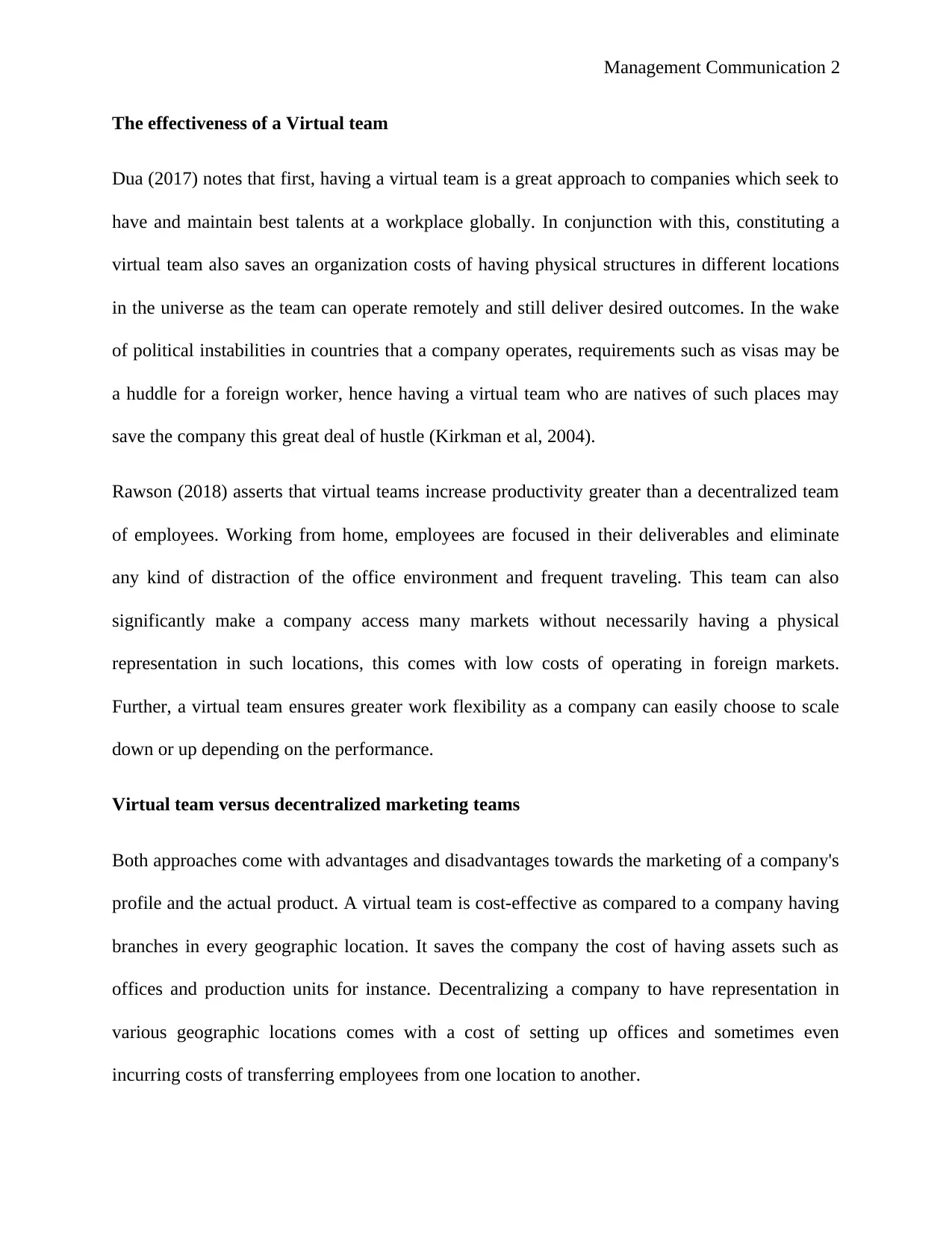
Management Communication 2
The effectiveness of a Virtual team
Dua (2017) notes that first, having a virtual team is a great approach to companies which seek to
have and maintain best talents at a workplace globally. In conjunction with this, constituting a
virtual team also saves an organization costs of having physical structures in different locations
in the universe as the team can operate remotely and still deliver desired outcomes. In the wake
of political instabilities in countries that a company operates, requirements such as visas may be
a huddle for a foreign worker, hence having a virtual team who are natives of such places may
save the company this great deal of hustle (Kirkman et al, 2004).
Rawson (2018) asserts that virtual teams increase productivity greater than a decentralized team
of employees. Working from home, employees are focused in their deliverables and eliminate
any kind of distraction of the office environment and frequent traveling. This team can also
significantly make a company access many markets without necessarily having a physical
representation in such locations, this comes with low costs of operating in foreign markets.
Further, a virtual team ensures greater work flexibility as a company can easily choose to scale
down or up depending on the performance.
Virtual team versus decentralized marketing teams
Both approaches come with advantages and disadvantages towards the marketing of a company's
profile and the actual product. A virtual team is cost-effective as compared to a company having
branches in every geographic location. It saves the company the cost of having assets such as
offices and production units for instance. Decentralizing a company to have representation in
various geographic locations comes with a cost of setting up offices and sometimes even
incurring costs of transferring employees from one location to another.
The effectiveness of a Virtual team
Dua (2017) notes that first, having a virtual team is a great approach to companies which seek to
have and maintain best talents at a workplace globally. In conjunction with this, constituting a
virtual team also saves an organization costs of having physical structures in different locations
in the universe as the team can operate remotely and still deliver desired outcomes. In the wake
of political instabilities in countries that a company operates, requirements such as visas may be
a huddle for a foreign worker, hence having a virtual team who are natives of such places may
save the company this great deal of hustle (Kirkman et al, 2004).
Rawson (2018) asserts that virtual teams increase productivity greater than a decentralized team
of employees. Working from home, employees are focused in their deliverables and eliminate
any kind of distraction of the office environment and frequent traveling. This team can also
significantly make a company access many markets without necessarily having a physical
representation in such locations, this comes with low costs of operating in foreign markets.
Further, a virtual team ensures greater work flexibility as a company can easily choose to scale
down or up depending on the performance.
Virtual team versus decentralized marketing teams
Both approaches come with advantages and disadvantages towards the marketing of a company's
profile and the actual product. A virtual team is cost-effective as compared to a company having
branches in every geographic location. It saves the company the cost of having assets such as
offices and production units for instance. Decentralizing a company to have representation in
various geographic locations comes with a cost of setting up offices and sometimes even
incurring costs of transferring employees from one location to another.
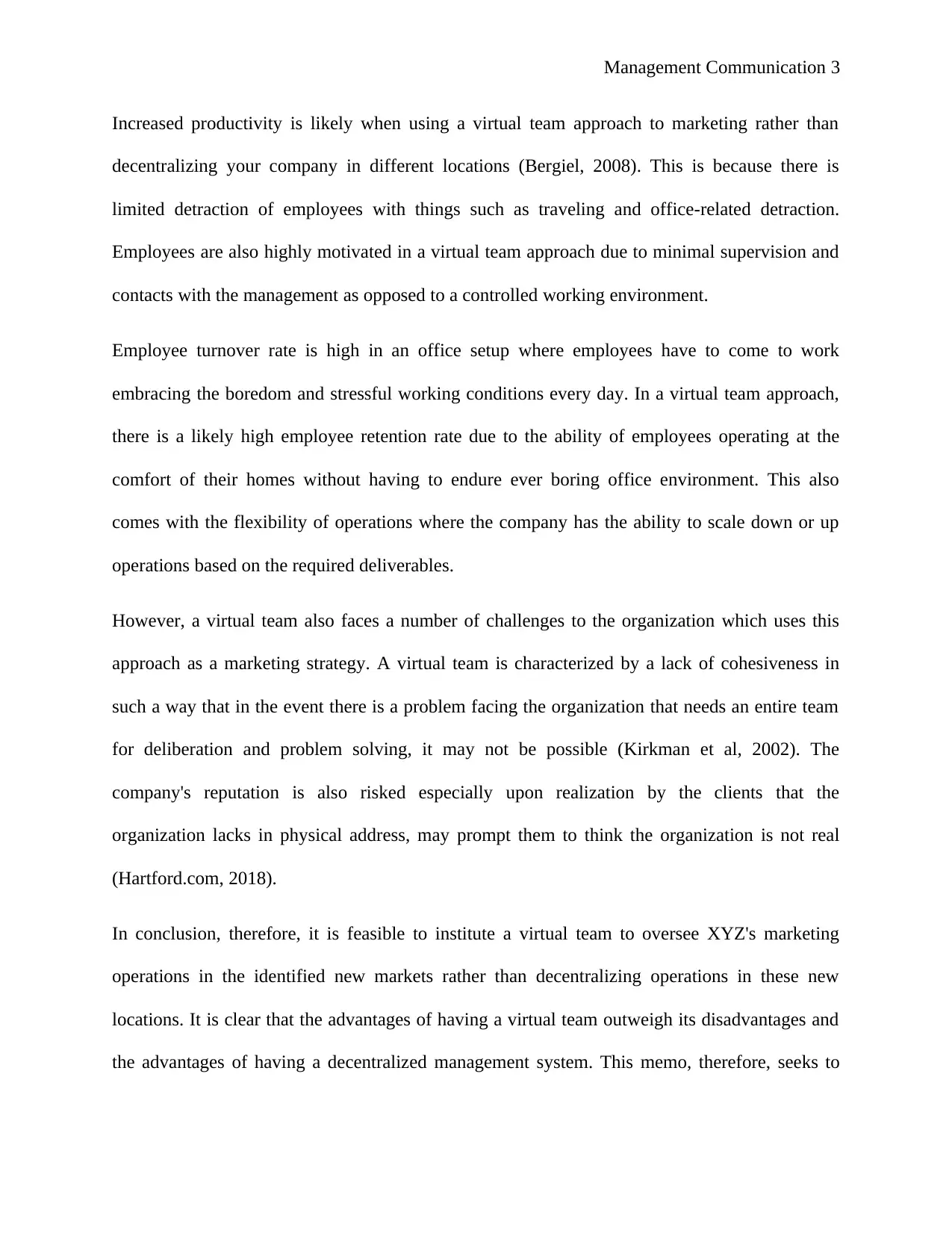
Management Communication 3
Increased productivity is likely when using a virtual team approach to marketing rather than
decentralizing your company in different locations (Bergiel, 2008). This is because there is
limited detraction of employees with things such as traveling and office-related detraction.
Employees are also highly motivated in a virtual team approach due to minimal supervision and
contacts with the management as opposed to a controlled working environment.
Employee turnover rate is high in an office setup where employees have to come to work
embracing the boredom and stressful working conditions every day. In a virtual team approach,
there is a likely high employee retention rate due to the ability of employees operating at the
comfort of their homes without having to endure ever boring office environment. This also
comes with the flexibility of operations where the company has the ability to scale down or up
operations based on the required deliverables.
However, a virtual team also faces a number of challenges to the organization which uses this
approach as a marketing strategy. A virtual team is characterized by a lack of cohesiveness in
such a way that in the event there is a problem facing the organization that needs an entire team
for deliberation and problem solving, it may not be possible (Kirkman et al, 2002). The
company's reputation is also risked especially upon realization by the clients that the
organization lacks in physical address, may prompt them to think the organization is not real
(Hartford.com, 2018).
In conclusion, therefore, it is feasible to institute a virtual team to oversee XYZ's marketing
operations in the identified new markets rather than decentralizing operations in these new
locations. It is clear that the advantages of having a virtual team outweigh its disadvantages and
the advantages of having a decentralized management system. This memo, therefore, seeks to
Increased productivity is likely when using a virtual team approach to marketing rather than
decentralizing your company in different locations (Bergiel, 2008). This is because there is
limited detraction of employees with things such as traveling and office-related detraction.
Employees are also highly motivated in a virtual team approach due to minimal supervision and
contacts with the management as opposed to a controlled working environment.
Employee turnover rate is high in an office setup where employees have to come to work
embracing the boredom and stressful working conditions every day. In a virtual team approach,
there is a likely high employee retention rate due to the ability of employees operating at the
comfort of their homes without having to endure ever boring office environment. This also
comes with the flexibility of operations where the company has the ability to scale down or up
operations based on the required deliverables.
However, a virtual team also faces a number of challenges to the organization which uses this
approach as a marketing strategy. A virtual team is characterized by a lack of cohesiveness in
such a way that in the event there is a problem facing the organization that needs an entire team
for deliberation and problem solving, it may not be possible (Kirkman et al, 2002). The
company's reputation is also risked especially upon realization by the clients that the
organization lacks in physical address, may prompt them to think the organization is not real
(Hartford.com, 2018).
In conclusion, therefore, it is feasible to institute a virtual team to oversee XYZ's marketing
operations in the identified new markets rather than decentralizing operations in these new
locations. It is clear that the advantages of having a virtual team outweigh its disadvantages and
the advantages of having a decentralized management system. This memo, therefore, seeks to
⊘ This is a preview!⊘
Do you want full access?
Subscribe today to unlock all pages.

Trusted by 1+ million students worldwide
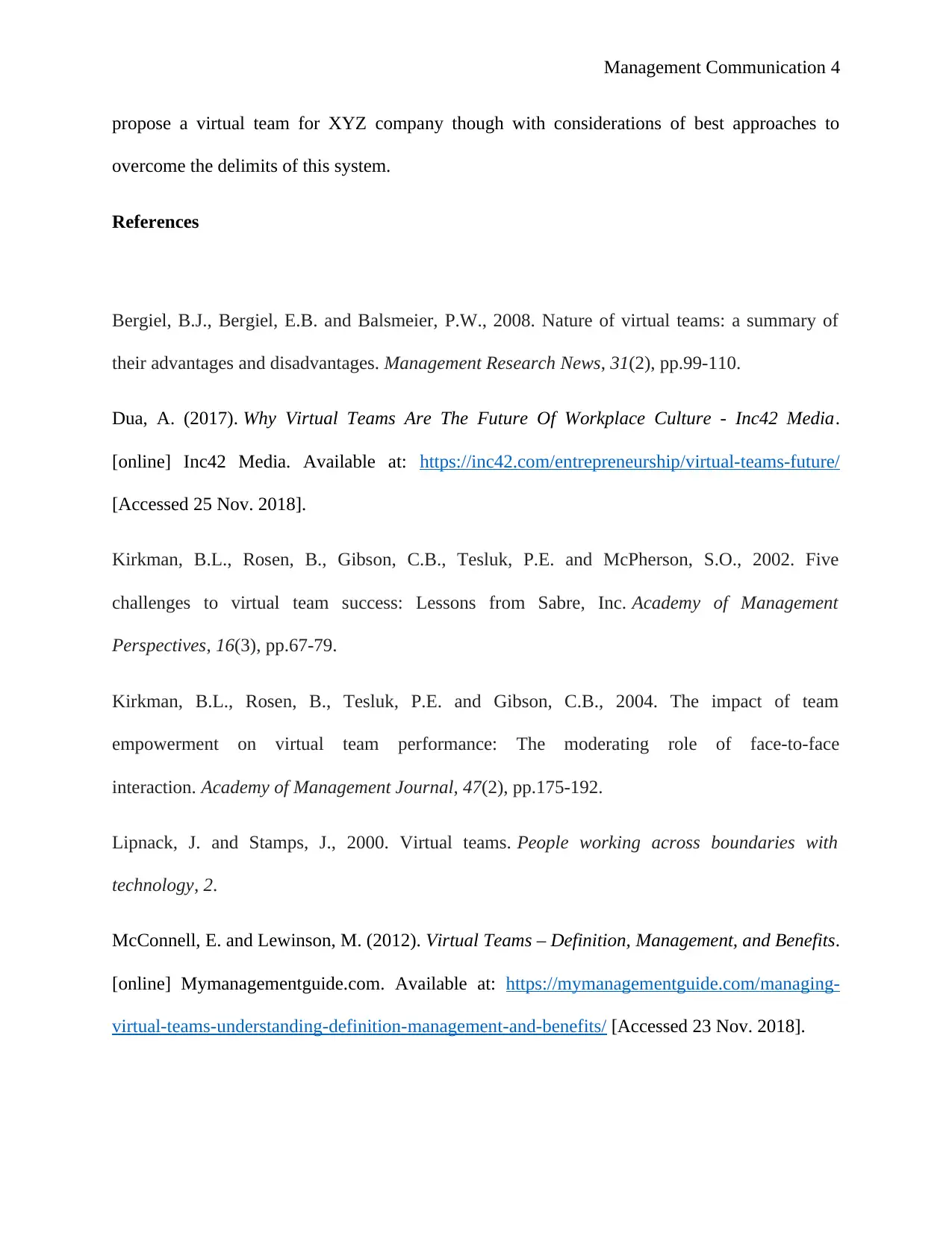
Management Communication 4
propose a virtual team for XYZ company though with considerations of best approaches to
overcome the delimits of this system.
References
Bergiel, B.J., Bergiel, E.B. and Balsmeier, P.W., 2008. Nature of virtual teams: a summary of
their advantages and disadvantages. Management Research News, 31(2), pp.99-110.
Dua, A. (2017). Why Virtual Teams Are The Future Of Workplace Culture - Inc42 Media.
[online] Inc42 Media. Available at: https://inc42.com/entrepreneurship/virtual-teams-future/
[Accessed 25 Nov. 2018].
Kirkman, B.L., Rosen, B., Gibson, C.B., Tesluk, P.E. and McPherson, S.O., 2002. Five
challenges to virtual team success: Lessons from Sabre, Inc. Academy of Management
Perspectives, 16(3), pp.67-79.
Kirkman, B.L., Rosen, B., Tesluk, P.E. and Gibson, C.B., 2004. The impact of team
empowerment on virtual team performance: The moderating role of face-to-face
interaction. Academy of Management Journal, 47(2), pp.175-192.
Lipnack, J. and Stamps, J., 2000. Virtual teams. People working across boundaries with
technology, 2.
McConnell, E. and Lewinson, M. (2012). Virtual Teams – Definition, Management, and Benefits.
[online] Mymanagementguide.com. Available at: https://mymanagementguide.com/managing-
virtual-teams-understanding-definition-management-and-benefits/ [Accessed 23 Nov. 2018].
propose a virtual team for XYZ company though with considerations of best approaches to
overcome the delimits of this system.
References
Bergiel, B.J., Bergiel, E.B. and Balsmeier, P.W., 2008. Nature of virtual teams: a summary of
their advantages and disadvantages. Management Research News, 31(2), pp.99-110.
Dua, A. (2017). Why Virtual Teams Are The Future Of Workplace Culture - Inc42 Media.
[online] Inc42 Media. Available at: https://inc42.com/entrepreneurship/virtual-teams-future/
[Accessed 25 Nov. 2018].
Kirkman, B.L., Rosen, B., Gibson, C.B., Tesluk, P.E. and McPherson, S.O., 2002. Five
challenges to virtual team success: Lessons from Sabre, Inc. Academy of Management
Perspectives, 16(3), pp.67-79.
Kirkman, B.L., Rosen, B., Tesluk, P.E. and Gibson, C.B., 2004. The impact of team
empowerment on virtual team performance: The moderating role of face-to-face
interaction. Academy of Management Journal, 47(2), pp.175-192.
Lipnack, J. and Stamps, J., 2000. Virtual teams. People working across boundaries with
technology, 2.
McConnell, E. and Lewinson, M. (2012). Virtual Teams – Definition, Management, and Benefits.
[online] Mymanagementguide.com. Available at: https://mymanagementguide.com/managing-
virtual-teams-understanding-definition-management-and-benefits/ [Accessed 23 Nov. 2018].
Paraphrase This Document
Need a fresh take? Get an instant paraphrase of this document with our AI Paraphraser
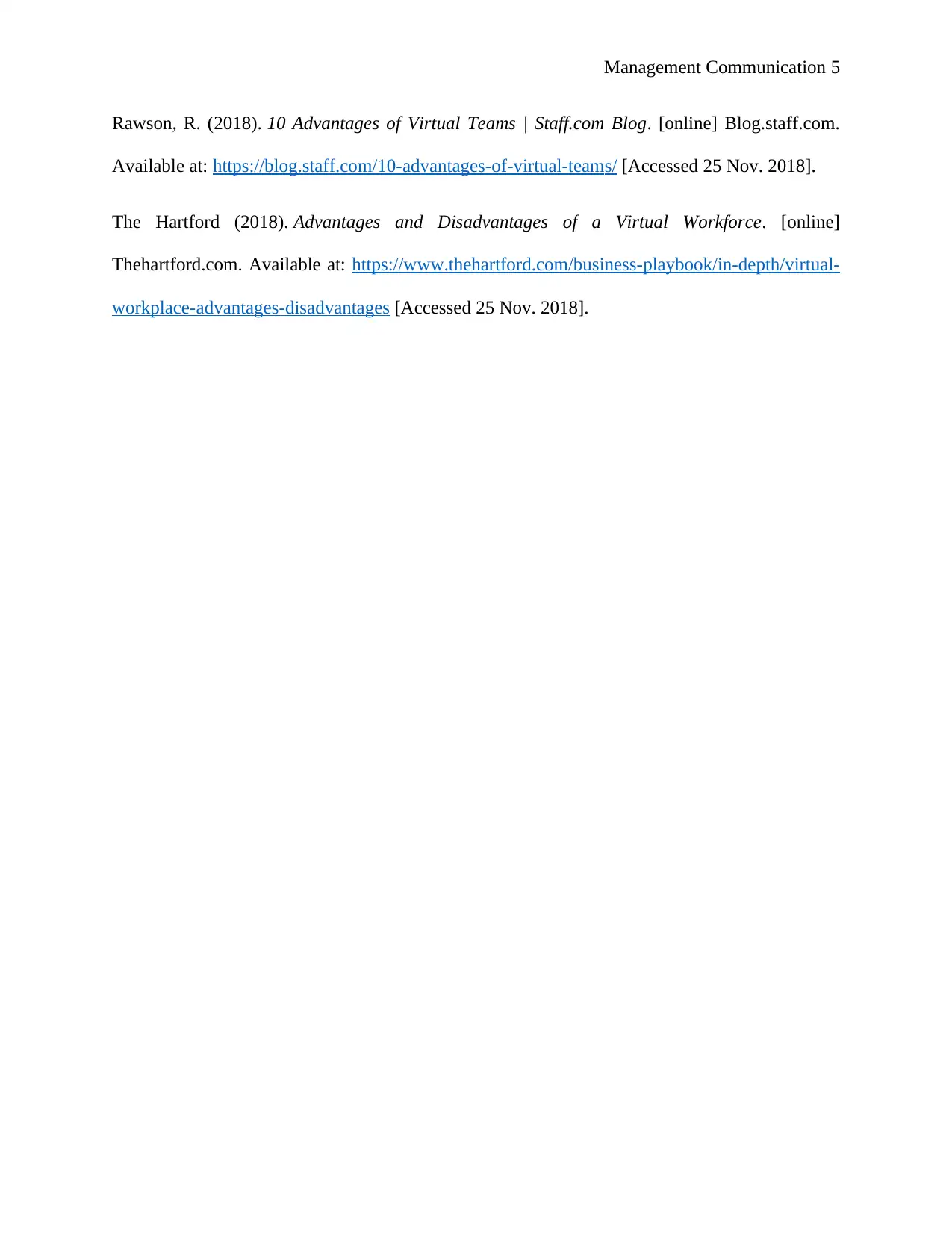
Management Communication 5
Rawson, R. (2018). 10 Advantages of Virtual Teams | Staff.com Blog. [online] Blog.staff.com.
Available at: https://blog.staff.com/10-advantages-of-virtual-teams/ [Accessed 25 Nov. 2018].
The Hartford (2018). Advantages and Disadvantages of a Virtual Workforce. [online]
Thehartford.com. Available at: https://www.thehartford.com/business-playbook/in-depth/virtual-
workplace-advantages-disadvantages [Accessed 25 Nov. 2018].
Rawson, R. (2018). 10 Advantages of Virtual Teams | Staff.com Blog. [online] Blog.staff.com.
Available at: https://blog.staff.com/10-advantages-of-virtual-teams/ [Accessed 25 Nov. 2018].
The Hartford (2018). Advantages and Disadvantages of a Virtual Workforce. [online]
Thehartford.com. Available at: https://www.thehartford.com/business-playbook/in-depth/virtual-
workplace-advantages-disadvantages [Accessed 25 Nov. 2018].
1 out of 5
Related Documents
Your All-in-One AI-Powered Toolkit for Academic Success.
+13062052269
info@desklib.com
Available 24*7 on WhatsApp / Email
![[object Object]](/_next/static/media/star-bottom.7253800d.svg)
Unlock your academic potential
Copyright © 2020–2025 A2Z Services. All Rights Reserved. Developed and managed by ZUCOL.



